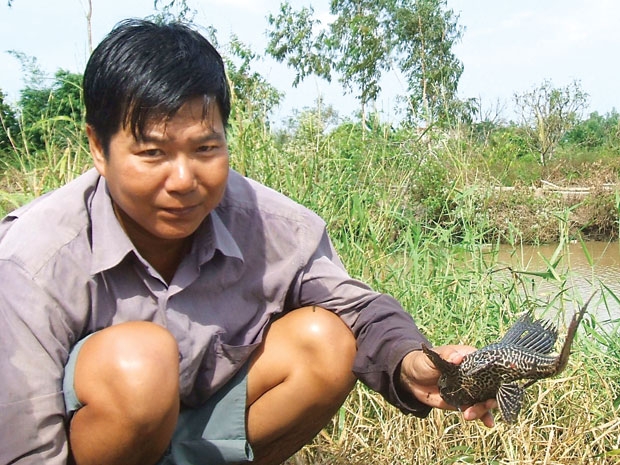
 |
Scientists have recently warned that suckermouth catfish (Hypostomus plecostomus) may seriously affect the fish farming in the provinces of Bac Lieu, Dong Thap, Kien Giang and Tay Ninh.
The catfish, together with the other 11 exotic species, are believed to be the danger to the native plants and animals, damaging the biodiversity in the Dong Nai Nature and Culture Conservation Area which has been recognized by UNESCO as the world’s biosphere reserve.
According to Dr. Tran Triet, Director of the Wetlands Research Institute, former lecturer of the HCM City National University of Natural Sciences, the main diet of suckermouth catfish includes weeds, moss, and algae. In new environments, some fish can be 70 cm long, while in the native environment, they are just 30 cm.
This is a very commonly seen fish species in many places in the world. The fish have escaped to the natural environment through trade and other channels. They have been considered as hazardous exotic species in some countries.
In the US, for example, the fish have “invaded” into some states such as Florida, Texas and Hawaii. Meanwhile, Singapore has reported that it has found suckermouth fish in natural waters.
Triet has cited the documents of the US Biological Resources as saying that suckermouth can exist in different conditions of the environment. They can live in the tranquil waters or the areas with fast flowing streams. They appear in shallow ponds and deep lakes. They mainly live in fresh water, but they can exist in brackish estuaries.
They can survive the contaminated water with the low dissolved oxygen concentration, or the stagnant waters with hydrogen sulfide. Being considered as tropical species, but they can exist in the areas with low temperature in the winter.
Scientists found out that suckermouth catfish can move on land for a certain distance, from an area to another living area.
“The wide ecological amplitude and strong viability help suckermouth become an ideal invader,” Triet commented.
He went on to say that the danger for Vietnam is that suckermouth catfish can develop strongly on the wetland natural reserve areas. If so, this would lead to the big disturbances in the aquatic ecosystem which can be seen in the imbalance in the food chain, as well as the direct competition with native fish species with the same habits.
“The final result would be the reduction in biodiversity,” Triet said.
Scientists have warned that it would be very difficult to control suckerfish once they develop in large populations. Some solutions have been suggested in the US, but they have not succeeded.
Therefore, Triet said that while waiting for a perfect solution, people, when discovering suckermouth fish need to exclude them out of the water areas.
Tran Minh Tri, MA, from the HCM City University of Agriculture and Forestry, also said that the development of suckermouth fish in many places in the world has threatened the local aquatic resources and the ecosystems.
(Source:VietNamNet)




